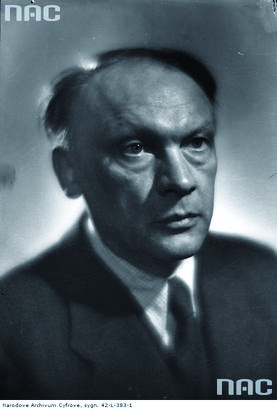Title of the work
Country of the First Edition
Country/countries of popularity
Original Language
First Edition Date
First Edition Details
Jan Parandowski, "Cyrk i arena", Dookoła świata 38 (1957): 12–13.
Genre
Article in a periodical*
Essays
Target Audience
Crossover (Schoolchildren, teenagers, young adults)
Cover

Cover with kind permission of the copyright holder for the magazine Dookoła Świata (1954–1976).
Author of the Entry:
Marta Pszczolińska, University of Warsaw, m.pszczolinska@al.uw.edu.pl
Peer-reviewer of the Entry:
Elżbieta Olechowska, University of Warsaw, elzbieta.olechowska@gmail.com
Katarzyna Marciniak, University of Warsaw, kamar@al.uw.edu.pl

Photograph by Edward Hartwig, retrieved from the National Digital Archives.
Jan Parandowski
, 1895 - 1978
(Author)
Classical philologist and archaeologist. An outstanding and prolific author of books related to Antiquity; translator of classical masterpieces. Contributed to many Polish newspapers and magazines. Chairman of the Polish PEN Club from 1933 to 1978. Recipient of prizes for outstanding literary achievements, such as a bronze medal received at the 1936 Berlin Summer Olympics for his book Dysk olimpijski [Olympic Discus]. Member of the European Society of Culture. In 1962 he was elected Vice-President of the International PEN. An exceptionally successful supporter and advocate of Classical Antiquity in Poland. His Mitologia. Wierzenia i podania Greków i Rzymian [Mythology. Beliefs and Legends of the Greeks and Romans], still often read even in primary school, remains for many generations of Polish readers a fundamental source of the knowledge of ancient myths.
Major works: Eros na Olimpie [Eros on the Olympus], 1924, Mitologia. Wierzenia i podania Greków i Rzymian [Mythology. Beliefs and Legends of the Greeks and Romans], 1924; Wojna trojańska [Trojan War], 1927; Oscar Wilde’s biography Król życia [A King of Life], 1930; Dysk olimpijski [Olympic Discus], 1933; Niebo w płomieniach [Heaven in Flames], 1936; Trzy znaki zodiaku [Three Signs of the Zodiac], 1938; Godzina śródziemnomorska [The Mediterranean Hour], 1949; a study on creative writing Alchemia słowa [Alchemy of the Word], 1951. He also translated into Polish Caesar’s Civil War, 1951, and Homer’s Odyssey, 1953.
Sources:
Krełowska, Danuta, Jan Parandowski: życie i twórczość, Toruń: Wojewódzka Biblioteka Publiczna i Książnica Miejska im. M. Kopernika, 1989.
Paciorkowska, Monika, Jan Parandowski, slideshare.net (accessed: December 30, 2020).
"Parandowski Jan", in Jadwiga Czachowska and Alicja Szałagan, eds., Współcześni polscy pisarze i badacze literatury. Słownik biobibliograficzny, vol. 6: N–P, Warszawa: Wydawnictwa Szkolne i Pedagogiczne, 1999, 254–260.
"Parandowski, Jan", in Encyklopedia PWN, encyklopedia.pwn.pl (accessed: December 30, 2020).
wikipedia.org (accessed: December 30, 2020).
Życiorys Jana Parandowskiego, kul.pl (accessed: December 30, 2020).
Bio prepared by Joanna Grzeszczuk, University of Warsaw, joannagrzeszczuk1@gmail.com
Summary
The weekly Dookoła świata [Around the World] (1954–1976) was intended to be a sort of travel magazine and “a window to the external world” for Polish teens in the Polish People’s Republic – see here [entry “Z antycznego świata”, Dookoła Świata 13 (1957)].
The article focuses on the Roman circus and amphitheatre. Both are presented as a building and as an institution. First, Parandowski writes about the beginning of the circus between the Palatine and Aventine Hills as a naturally convenient location and then describes the building founded by Julius Caesar and finished by Augustus. Next, Parandowski presents spectacles that took place at the circus providing a religious and socio-political background and using historical examples. In the second part of the text, amphitheatres and various games performed there are described in detail, with a particular focus on people, animals and their traditional roles. The third part, and the most extensive, discusses the Flavian Amphitheatre, its history and the phenomenon of its longevity in literature and culture of all ages.
Analysis
Although the article refers to history, it is in line with the other contents of the magazine, presenting fascinating places and cultures outside of communist Poland of the 1950s. Rome has become an extremely popular city since the movie Roman Holiday with Audrey Hepburn and Gregory Peck was released in 1953 (dir. William Wyler). Young people in Poland, unable to travel, wanted to watch and read about places their favourite couple drove around on a Vespa. As one of the most important and characteristic places shown in the film, the Colosseum was widely known, but this knowledge was superficial. Everyone knew what it looked like on screen, but the broader understanding was sparse. The text aims to fill this gap and to familiarize the reader with two institutions of ancient Rome. It achieves its goal as it provides, in an accessible manner, not only textbook facts but also vivid genre scenes depicted by the author, which are easy to imagine and remember. These scenes, referring to entertainment as a field important to young people, break the convention of didacticism to ensure that young people fully benefit from the article.
Further Reading
Selected bibliography concerning Jan Parandowski’s work and life see here.
Frycie, Stanisław, “Czasopisma dla dzieci i młodzieży okresu powojennego (1945–1970)”, Kwartalnik Historii Prasy Polskiej 3 (1977), 49–73.
Harjan, George, “Jan Parandowski: A Contemporary Polish Humanist”, Books Abroad 34. 3 (1960): 223–226.
Waksmund, Ryszard, “Periodyki dziecięce w systemie prasy. Propozycje metodologiczne do badań nad czasopiśmiennictwem dla dzieci i młodzieży”, Litteraria vol. 14 (1982), 149–163.


